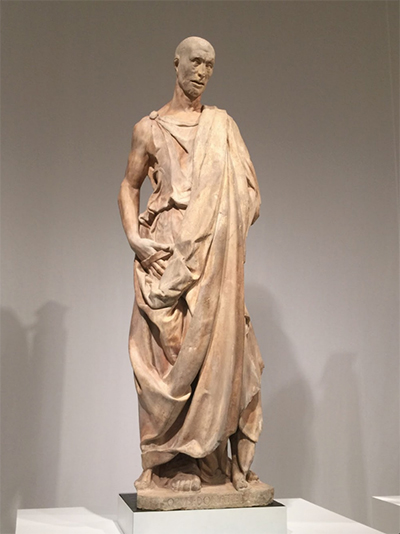Zuccone (Lo zuccone) is a sculpture by the famous sculptor Donatello.
The word Zuccone is Italian, and it loosely translates to pumpkin. However, figuratively, the word means bald head. This alludes to the bald head of the sculpture. Zuccone was completed between 1423 and 1425 as part of the Prophet Series commissioned for the Florence Cathedral.
Today, however, the sculpture can be found at Museo dell’Opera del Duomo. This sculpture was considered the most important of the 15th century. This statue is also popularly known as the Statue of Habakkuk as most people believe that it is a depiction of the Biblical prophet Habakkuk.
A closer look at Zuccone
Zuccone is a naturalistic and realistic sculpture, showing a style that was different from that of artists in the 15th century. This was one of the most life-like statues in the time of Donatello and was undoubtedly his favourite. Vasari, a fellow artist, would later write that Donatello would talk to Zuccone, even before the sculpture was complete.
Habakkuk's life in the Bible is bleak as very little information about his private life exists. This gave Donatello significant artistic freedom to craft his version of the prophet. What made Habakkuk stand out from the rest of the prophets was that he was not afraid to question God about the injustices he allowed on the people of Judah. This notion inspired Donatello to create the melancholic look of the sculpture.
The figure of Zuccone is sinuous, prompting the human eye to move around the sculpture gradually. The stature taken by Zuccone is that of a slender man who wears a toga. The toga is characterised by raffles and layers, a clear depiction of Donatello’s dedication to details. The head of Zuccone is bald and bent downwards, showing his humility.
His eyes call out to the viewer as they appear void and sad, but at the same time, they acknowledge the presence of the viewer. His lips are slightly parted, reflecting the human nature. His right hand holds a scroll and clutches onto his toga as well while the left one points downwards. The feet of Zuccone can be seen at the bottom of his toga, which shows the end of the statue as well. The great level of detail employed in this sculpture gives it a life-like quality.
Medium and Technique
Zuccone is a marble sculpture. Marble is metamorphic, meaning that it is formed when rocks are transformed by pressure or heat. Mostly, the rock is made from calcite. Over centuries, this material has been valued by architects and sculptors alike. Sculptors favour marble for many reasons. One of them is its translucent quality. This translucency resembles that of the human skin which helps to give sculptures a life-like look and adds on to the realism of these sculptures.
When newly quarried, marble is easy to work with due to its softness. As the material ages, it hardens, making it durable as it cannot be destroyed by the elements of weather such as water and wind. However, the material has its disadvantages as well. Despite its resistance to weather withering, it is susceptible to tear when in environments with acidic rain. Marble also absorbs skin oils as the artist works with it, which may lead to staining.
The technique Donatello used for Zuccone was different. The sculptor had spent the earlier years of his career as an apprentice and was later able to develop an outstanding technique that influenced his contemporaries for the rest of the 15th century. The technique used to make Zuccone and other marble statues is known as relief.
This technique involves the use of light and shallow carving on the surface of the marble to bring about life-like. However, he added texture to his sculpture by contrasting rough and smooth textures. Instead of chiselling these forms, he seemed to be painting. This is a style that was mimicked by later artists such as Michelangelo.
Artworks related to Zuccone
One other sculpture that is always compared to Zuccone is Jeremiah. Jeremiah was also part of the series of prophets that were commissioned for the cathedral of Florence. Just like Zuccone, Jeremiah is a sorrowful man. He wears a toga just like Habakkuk. However, he has a head full of hair which contrasts him to Zuccone. His firm jaw and closed lips contrast to Zuccone's bald head and parted lips and give him an air of authority. Just like Zuccone, the feet mark the end of the sculpture.
Themes Presented by Zuccone
Zuccone is a sculpture that appeals to human spirituality. Habakkuk was a prophet in anguish, wondering why God used a nation such Babylon to punish Judah. His anguish and complaints to God remind viewers of their own spiritual and personal struggles and their relationship with God. It also reminds viewers of the human nature. Even a prophet who was supposed to relay God’s word could question him.




